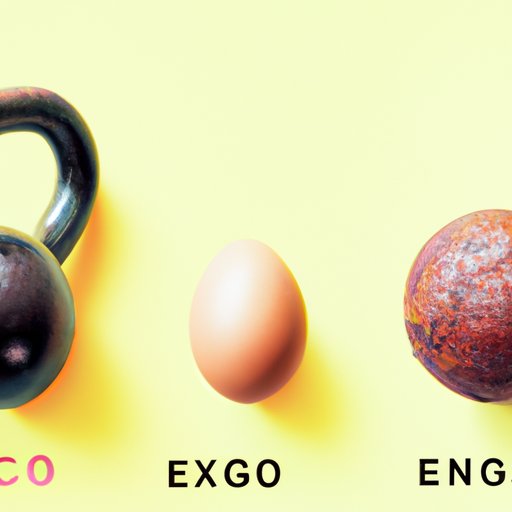
Introduction
Have you ever wondered how many calories weight lifting burns? Many people assume that weight lifting is only for building muscle and not burning calories, but that couldn’t be further from the truth. The purpose of this article is to explore the calorie burning potential of weight lifting and provide readers with accurate information that can help them incorporate weight lifting into their fitness routines.
The Calorie Burning Potential of Weight Lifting
Before we dive into the specifics of weight lifting and calorie burn, it’s important to understand the concept of calorie burning. Calories are a unit of measure for energy, and the number of calories we burn during exercise depends on several factors, including the type of exercise, the duration and intensity of the exercise, and factors related to individual differences such as age, weight, and fitness level.
Now, let’s talk about the calorie burning potential of weight lifting. The truth is that weight lifting can burn a significant number of calories. According to the American Council on Exercise, a 150-pound person can expect to burn around 112 calories during a 30-minute weight lifting session. Of course, this number will vary depending on factors like the person’s weight, the exercises performed, and the intensity of the workout.
Weight Lifting and Muscle Growth’s Impact on Calorie Burn
One of the ways weight lifting can impact calorie burn is through its effect on muscle growth. When we lift weights, we create small tears in our muscles, which then repair and grow back stronger. This process, known as muscle hypertrophy, requires energy, and thus burns calories. Additionally, having more muscle mass can increase our metabolic rate, which means we burn more calories even when we’re at rest. This effect can last for hours or even days after a weight lifting session, depending on the intensity of the workout.
Another factor that contributes to calorie burn during weight lifting is EPOC, or excess post-exercise oxygen consumption. This refers to the increased oxygen uptake that occurs after a workout as the body works to restore depleted energy stores. EPOC can account for up to 15% of the total calories burned during a workout, and can last for several hours after the workout has ended.
Comparing Calorie Burn During Weight Lifting to Other Forms of Exercise
While weight lifting can burn a significant number of calories, it’s important to acknowledge that other forms of exercise can be more effective for calorie burn. Cardio activities like running, cycling, and swimming tend to burn more calories per minute than weight lifting. High-intensity interval training (HIIT) is another effective way to burn calories, as it combines short bursts of intense exercise with periods of rest or active recovery.
That being said, there are several factors that can impact calorie burn during each type of exercise. For example, the intensity of a weight lifting workout can greatly impact calorie burn. A high-intensity weight lifting session will burn more calories than a low-intensity cardio workout. Additionally, individual differences like weight and fitness level can impact calorie burn across different forms of exercise.
The Impact of Weight and Intensity on Calorie Burn During Weight Lifting
The amount of weight lifted and the intensity level of a weight lifting workout can also impact calorie burn. Generally, heavier weights and higher intensity levels will result in more calories burned. For example, a 2017 study published in the Journal of Strength and Conditioning Research found that participants burned significantly more calories during a high-intensity weight lifting session compared to a low-intensity session.
Keep in mind, though, that using too much weight or lifting at too high of an intensity can increase the risk of injury. It’s important to choose a weight and intensity level that feels challenging but still allows for proper form and technique.
Debunking Common Misconceptions About Weight Lifting and Calorie Burn
There are several common misconceptions about weight lifting and calorie burn that need to be addressed. One of the most prevalent is the idea that weight lifting only builds muscle and doesn’t burn many calories. As we’ve discussed, weight lifting can actually burn a significant number of calories, particularly when done at a high intensity.
Another misconception is that weight lifting is only for men or people looking to bulk up. In reality, weight lifting can benefit anyone, regardless of gender or fitness goals. It can help improve bone density, increase metabolic rate, and enhance overall fitness and functional strength.
Tips for Maximizing Calorie Burn During Weight Lifting Workouts
If you’re looking to maximize calorie burn during your weight lifting workouts, there are several things you can do. One strategy is to incorporate compound exercises, which work multiple muscle groups at once. Examples of compound exercises include squats, deadlifts, and bench press. These exercises require more energy and can help you burn more calories than isolated exercises like bicep curls or tricep extensions.
Another way to boost calorie burn is to incorporate supersets or circuit training into your weight lifting routine. This involves performing multiple exercises back-to-back with little or no rest in between, which can help keep your heart rate up and increase calorie burn.
Conclusion and Summary
So, how many calories does weight lifting burn? While weight lifting may not be the most effective form of exercise for calorie burn, it can still burn a significant number of calories, particularly when combined with other strategies like high intensity, compound exercises, and circuit training.
The benefits of weight lifting go far beyond calorie burn, though. It can help improve overall fitness, increase metabolic rate, and enhance muscle growth and functional strength. If you’re looking to incorporate weight lifting into your fitness routine, be sure to start with a weight and intensity level that feels challenging but safe, and consider working with a certified personal trainer if you’re new to weight lifting.




